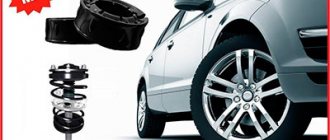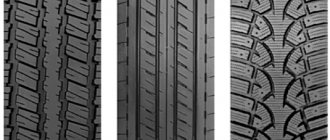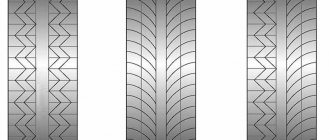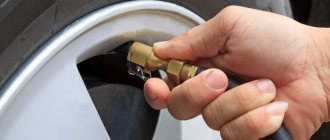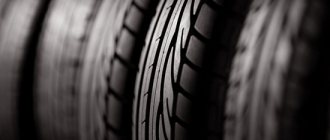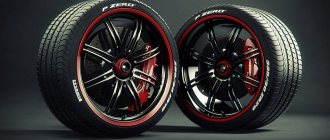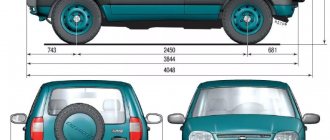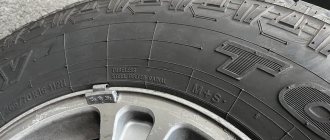p>Everyone performs their own specific task. The frame gives the tire its shape and determines its rigidity. The next layers of the pneumatic tire form a breaker - an intermediate part of rubber between the tread and the frame, which takes the main load when moving. The breaker is fixed with metal cord. Tires differ in the structure of the frame and belt, the location and material of the cord threads. Today, many manufacturers offer radial and bias-ply tires for cars. Let's take a closer look at the structural features, differences, advantages and disadvantages of these tires.
Diagonal tire
The tire frame consists of a multi-layer cord, the threads of which are “laid” at an angle of 35-40 degrees from one bead to the other strictly diagonally. The threads adjacent to each other intersect exactly in the middle of the tire tread, ensuring high reliability of the carcass. Accordingly, overlapping threads are possible only with an even number of cord layers: 2, 4, 6 or 8. Cord threads in bias-ply tires are made of synthetic materials: nylon or nylon.
Advantages:
- high strength of the side walls - the diagonal arrangement of the cord threads and the multi-layer structure of the frame ensure good resistance of the “sidewalls” to damage and tearing;
- simple design - tires are cheaper and easier to repair;
- adaptability to harsh operating conditions - diagonal tires, unlike radial tires, are often used in equipment intended for off-road driving.
The disadvantages include:
- short period of operation;
- the tread is subject to increased deformation, which reduces the adhesion properties of the tire - diagonal tires are especially susceptible to “crushing” when the load changes while driving;
- heavy weight - in comparison with radial models, the difference in weight is significant;
- synthetic cord has lower thermal conductivity - tires are less resistant to overheating.
Such models can be seen on special equipment - wheeled tractors, excavators.
How to install bias tires? To install tires with a directional tread pattern, you must follow the special markings. Usually this is an arrow on the side of the wheel indicating the desired direction of rotation.
What is the difference
Before you understand which rubber product is better, you need to study the structure of each. The main difference is in the internal structure of the “rubber”. Each tire consists of several components. The difference between the products is in the arrangement of the constituent elements.
Diagonal - consists of several cord layers, overlapping, along an oblique line (in the form of a herringbone). Radial “rubber” is also a multilayer structure, but all its constituent elements have a transverse arrangement.
Radial tire design
The frame has one layer. The radius of a car tire is determined by the type of placement of the cord threads, which are laid along the tire tread at an angle of 90 degrees, without intersecting. Additionally, in places where the rubber contacts the road surface, the frame is reinforced with a “tight” belt - metal cord. Unlike bias tires, metal cord is made from thin steel cable with a diameter of 0.15-0.30 mm. This material provides high durability and resistance to overheating.
Advantages:
- long period of operation - the radius of tires allows you to reduce the tension of the cord threads in contact with the road and increase the service life of the tires;
- good heat dissipation during movement - steel metal cord better protects rubber from overheating than synthetic threads;
- better traction with the road surface - differences in the cord design, as well as more durable material of the belt belt, ensure good contact with the supporting surface;
- high load-bearing capacity, maximum speed - according to these characteristics, the difference is 15-20% in favor of radial tires. This tire is much lighter than a bias-ply tire.
Flaws:
- low strength of the side wall - almost always the radius of the tire reduces the resistance of the “sidewalls” to mechanical damage;
- high cost compared to diagonal analogues.
How to install radial tires on a car? A tire with a directional tread pattern must be installed, paying attention to the marking of the direction of travel - indicated by an arrow. If you are using tires with an asymmetrical tread type, then you should look for the inscription “Outside” on the sidewall. Additionally, on the inside of the rubber there may be the inscription “Inside” (inside). Directional tires are also marked on the sides of installation on the equipment. Tires labeled “Left” are for left wheels, and “Right” are for right wheels.
How the tire is made
Before considering the design of a radial-type product, let's look at their general structure:
- frame - serves to give and maintain shape, as well as for strengthening;
- breaker - ensures a smooth transition to the outer part, accepts, distributes, and compensates for loads from the rim;
- cord - polymer and metal threads that play a reinforcing role;
- tread is an outer covering with a specific pattern that is in direct contact with the road.
This design is considered optimal and is still relevant today. On the one hand, the wheel has nothing extra that could add to the overall weight and negatively affect the speed and maneuverability of the vehicle; on the other hand, manufacturers take utmost care of the reliability and durability of the product.
Popular tire models
- Yandex.Market rating: Yandex.Market: 4.5
Goodyear Eagle F1 Asymmetric 3 SUV tiresSeasonality: summer Spikes: no Diameter: 17 / 18 / 19 / 20 / 21 / 22
- Yandex.Market rating: Yandex.Market: 4.5
Goodyear Eagle Sport TZ tires
Seasonality: summer Spikes: no Diameter: / 16 / 17 / 18
- Yandex.Market rating: Yandex.Market: 4.5
Goodyear EfficientGrip Performance Tires
Seasonality: summer Spikes: no Diameter: 15 / 16 / 17 / 18 / 19 / 20
- Goodyear UltraGrip Arctic 2 SUV Tires
Seasonality: winter Spikes: yes Diameter: 17 / 18 / 19 / 20 / 21
- Yandex.Market rating: Yandex.Market: 4.5
Goodyear UltraGrip Ice 2 tires
Seasonality: winter Spikes: no Diameter: 15 / 16 / 17 / 18 / 19
- Yandex.Market rating: Yandex.Market: 4
Goodyear Wrangler HP All Weather Tires
Seasonality: summer Spikes: no Diameter: 16 / 17 / 18 / 19
- Yandex.Market rating: Yandex.Market: 4.5
Goodyear Vector 4Seasons tires
Seasonality: all-season Spikes: no Diameter: 15 / 16 / 17 / 18
- Yandex.Market rating: Yandex.Market: 4
Goodyear EfficientGrip 2 SUV Tires
Seasonality: summer Spikes: no Diameter: 16 / 17 / 18 / 19 / 20
- Yandex.Market rating: Yandex.Market: 4.5
Goodyear UltraGrip Ice SUV Tires
Seasonality: winter Spikes: no Diameter: 16 / 17 / 18 / 19 / 20 / 21
- Yandex.Market rating: Yandex.Market: 4.5
Goodyear Wrangler All-Terrain Adventure tires with Kevlar
Seasonality: summer Spikes: no Diameter: 15 / 16 / 17 / 18 / 20
- Yandex.Market rating: Yandex.Market: 4.5
Goodyear EfficientGrip SUV Tires
Seasonality: summer Spikes: no Diameter: 16 / 17 / 18 / 19 / 20 / 21 / 22
- Yandex.Market rating: Yandex.Market: 4
Goodyear Eagle F1 Asymmetric SUV tires
Seasonality: summer Spikes: no Diameter: 17 / 18 / 19 / 20 / 22
- Goodyear UltraGrip Performance+ SUV Tires
Seasonality: winter Spikes: no Diameter: 16 / 17 / 18 / 19 / 20 / 21
- Yandex.Market rating: Yandex.Market: 5
Goodyear Vector 4Seasons Gen-3 SUV Tires
Seasonality: all-season Spikes: no Diameter: 16 / 17 / 18 / 19 / 20
Tire markings
Manufacturers mark the main characteristics of the tire product on the side surface: type of construction (radial or diagonal), dimensions (diameter, profile). The marking system can be metric, inch or mixed.
The difference between the markings of a radial tire and a diagonal tire is the presence of the letter “R”. Next, the manufacturer can set the size in millimeters - 185/60R15 or 185 R15. In two versions, 185 is the width of the tire, 60 is the height as a percentage relative to the width. The absence of a “slash” indicates that the tire has a full profile. That is, the profile height and tire width are the same.
How to distinguish a design with a diagonal cord structure? Firstly, there are no letters in the markings. Secondly, dimensions are given in inches. Regular tires can also be distinguished from full-profile tires by the presence of a “/” sign, respectively.
Wheel in galoshes
In 1910, the American company BF Goodrich Company began adding highly dispersed amorphous carbon or simply soot to the rubber mixture to increase strength. The rubber abraded less, but the elasticity of the wheel immediately decreased. Therefore, engineers decided to make the tread and tire as separate elements.
Back then, tires were made from natural raw materials and were white or beige. And the tread with carbon soot inside turned out to be black. As a result, the lower black casing of the tires looked like galoshes. A disposable tread was installed on reusable tires and the wheel was used much longer than usual. Such black and white tires can still be seen on restored vehicles, as well as in films of the twenties.
Removable tread was used for some types of tires until the sixties. In the sixties, similar composite wheels were produced by the Yaroslavl Tire Plant for GAZ trucks. However, as speed and load increased, this design turned out to be ineffective.
To avoid slippage of the removable tread and its failure, they began to make a monolithic tire. The tread was welded on top, like other layers of rubber. The rudiment of these technological processes is now the so-called vulcanization, in which old truck tires are given a new tread.
Difference between radial and bias tire
Let's highlight a few significant differences:
- Number of layers of cord, arrangement of threads, materials of manufacture. The main difference between a radial tire and a bias tire is the design feature. In the first option, one layer, the threads are laid along the tire without crossing, a metal cord is used. In the second, there is a multilayer frame, threads made of synthetic materials, overlapped (crossed).
- Operational properties. These include service life, resistance to overheating, ability to withstand loads, and controllability. Radial tires will vary in many ways for the better. The only exception is the resistance of the sidewalls to mechanical damage. It is higher for diagonal cord.
- Marking difference. Tires of different designs are marked differently. Radial ones are necessarily designated by the letter “R”. Even without understanding other features, you can easily distinguish different types of tires.
- Weight, cost, ease of repair. The radial type of tires is more expensive, but lighter in weight. However, bias tires are easier to repair.
If you are the owner of a passenger car or small truck, the question of how to distinguish car tires simply will not arise. The automotive market mainly offers radial tires as more reliable and durable in use. Diagonal tires are used for installation on special equipment that operates off-road or in difficult conditions.
Trawl trailer - tow truck for passenger cars: design options, models
- short service life;
- ability to withstand lighter loads;
- worse wear resistance;
- do not provide good adhesion to asphalt;
- do not guarantee improved handling;
- the frame is made of synthetics, which reduces thermal conductivity;
- have a lot of weight;
- not suitable for modern passenger cars.
If you can still somehow argue with the last point, then all the other shortcomings are beyond doubt.
As a result, we see a picture in which diagonal structures are moving further away from passenger cars. Their main area of application is tractors, excavators and other special equipment.

